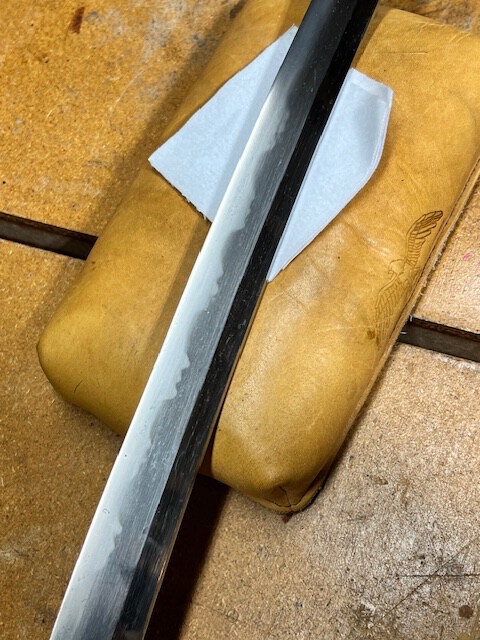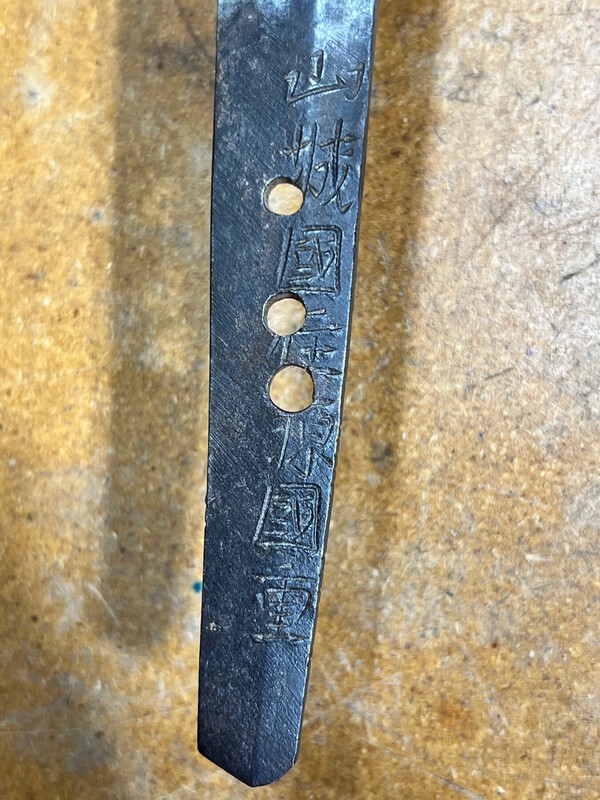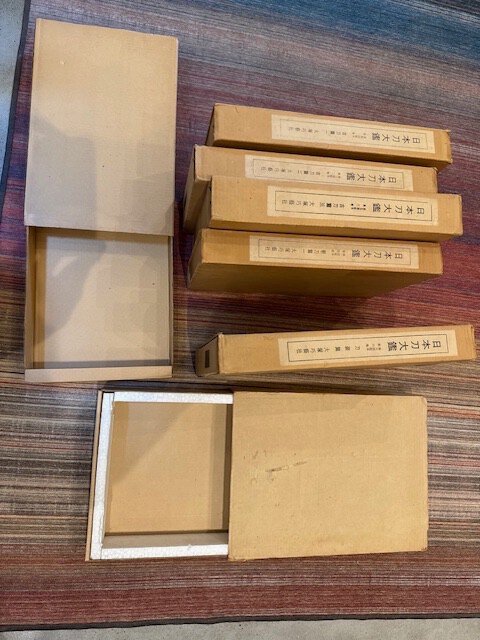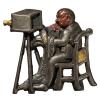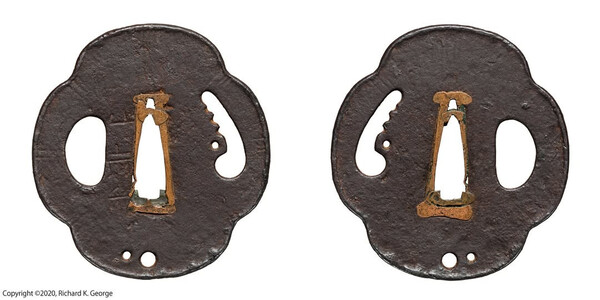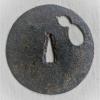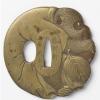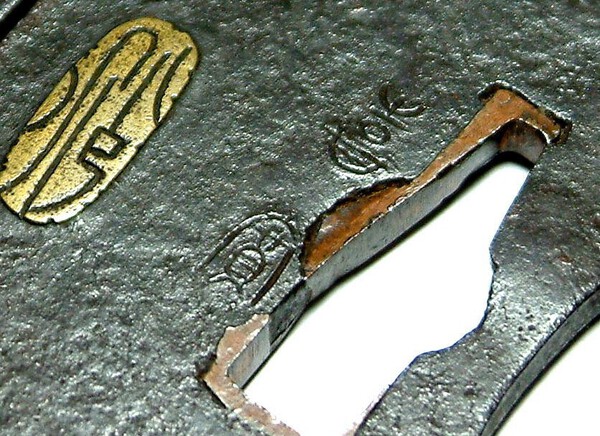All Activity
- Past hour
-
Looks like Yamashiro no Kuni ju Minamoto Kunishige
-
Tyler sword changed their profile photo
-
Kunishige? It is a nicely forged Wakizashi with a very distinct hamon. Of course I’m wondering if anybody is familiar with the Smith and school and any information you could provide or direction to point me in thank you.
- Today
-
@Mantis dude Yes probably the shinsa team is the only one to give a solid answer if they would - unfortunately I was not into tosogu when I was in Japan and now I am into it but lost my Japan cell number. Your love for mantis is outrageous!! I didn't know that kaga people also do nanako on hira-zougan. I thought that was a unique technique by the Ichijo school. Nice collection! It always cheers when seeing similar pieces on books (or better, the same pieces).
-
These are seven original shipping and storage boxes for the Nihonto Taikan volumes. Each is made of cardboard and has styrofoam to cushion the book (books not included). Three of them are slightly deeper than the others. Good condition with each having been marked on one end with black marker. $100 USD for all plus actual shipping cost. These weigh about 7 pounds, so shipping should be less than $40 within the continental USA by UPS Ground.
-
I am happy for you and hopeful it works out. Either way, I would count it as a win for the stated reasons you gave.
-
@Charlie C I was just thinking after looking at all these papers online- is it perhaps possible that Kaga Goto would be considered a subset of Kaga Kinko and therefore they are assigning the most conservative answer to an item? only thing I can think of, but it is pure conjecture on my part and I guess only way to get a real answer would be to contact the shinsa team/ organization? My last thought on the topic @Curran - Love the pieces, especially the father/son kozukas- rare opportunity to study a family line I have posted these before but figured it doesn't hurt to do it again. From The Kaga Kinko Taikan a picture of the bottom page along with 2 tsuba I own- needless to say I liked the pieces in hand and thought it was fun to have a page collected (not the exact pieces in the book but obviously same design) Closer Pics:
-
Dude he had many signatures. Bonhams : KANŌ TAN'YŪ (1602-1674) Su Shi (So Tōba) on His Mule Edo period (1615-1868), 17th century https://share.google/DVHDVD9uvf2Fk2pI8
-
Here are a few of my pieces that have been repaired like that which I could access images of easily... Best, rkg (Richard George)
-
Not that I know of. Brian attends most if not all the sword shows here in the U.S. , if you would prefer to meet with him in person.
-
Pretty cool blade in my own opinion for sale by Aoi, already a bid for 23,500,000 Yen. Interested to hear everyone’s thoughts on a decently expensive blade. https://sword-auction.com/en/product/27515/as25316-katana-in-shirasaya-with-koshirae-nbthk-tokubetsu-hozon-token-consignment-sale-signature-nagasone-okisato-nyudo-kotetsu/
-
Very interesting and educational thread, will be reading each entry, day by day. Regardless of outcome, thank you all for joining the discussion 👍
-
https://en.wikipedia.org/wiki/Kanō_Tan'yū
-
Ford was a magician. His knowledge on restoration, re-patination etc was unequalled. He restored many pieces for me that I would never have entrusted to anyone else nor would I have dreamed of tackling them myself. It isn’t just the “cleaning” you need to undertake, it’s the putting it right when it goes wrong……and it will go wrong. Ford had all of that knowledge. I am aware of just one other person whose workshop is fully capable.
-
Alright, I am convinced. I'd better buy a sponge to absorb future sulfur instead.
-
Thanks Franco, is Brian also on this forum? I am the kind of person who would rather not call people I have never met to consult...
-
Ditto. When it comes to silver, I absolutely agree with Colin. Translated through Gordon Robinson, a shinsa judge showed us a koshirae where he had cleaned the silver when he was much younger- not knowing better. With shame face, he pretty much said "don't do it". Ford was Ford. Unless it is with someone at that level, don't touch it. Even then, think about it for a long time before doing. It is hard to go back.
-
Thanks Colin - I know this is the most rational option. I asked this because of this post , and the removal of silver sulfide on item 315 clearly has a pronounced effect. Of course Ford knows his job, I just wonder if other people also had similar experiences.
-
Brian Tschernega - professional cleaning / restoration (425) 771-6339 .
-
Matsunoki started following Cleaning the tarnish on silver iroe
-
Charlie….simple….don’t clean it. It is so easy to ruin the appearance of just about anything that involves silver or any of the alloys (shibuichi, shakudo etc). Subtle age patina is an important factor that should not be disturbed. Cleaning is also likely to have drastic effects on the financial value (as well as the aesthetic value)
-
Coming back to the main topic, one of my tsuba where the copper insert intends to repair the damages done to the nakago ana to fit a new blade.
-
Charlie C started following Cleaning the tarnish on silver iroe
-
Dear Forum, I know that this is a rather controversial topic, but I wonder what your opinions are on the cleaning of the silver/shibuichi on antique tosogu, which often produces a quite unpleasant uneven dark grey/black tone tarnish (likely silver sulfide?). I am aware that it could be dangerous to make any move on them since these are often a very thin silver/shibuichi layer. I wonder how you determine if something is cleanable, and how you clean it if so. I found some discussion online using acidified thiourea or 5% hydrogen peroxide to remove the tarnish chemically, but I am not sure if they can be applied to tosogu. I would appreciate any suggestions. C. C.
-
As an aside I have noted that this type of guard is often fabricated from two pieces in the first place, the guard and lower part of the knucklebow in one and the upper part of the knucklebow as a separate piece. This allows the length to be adjusted to suit the sword, the joint is often an L shaped splice that has been silver soldered, very hard to spot. It would seem therefore that Brian's suggestion would be perfectly acceptable. Let us know how this turns out. All the best.



.thumb.webp.5eaa7e4ba7e2767ad635821f74fa0a30.webp)



